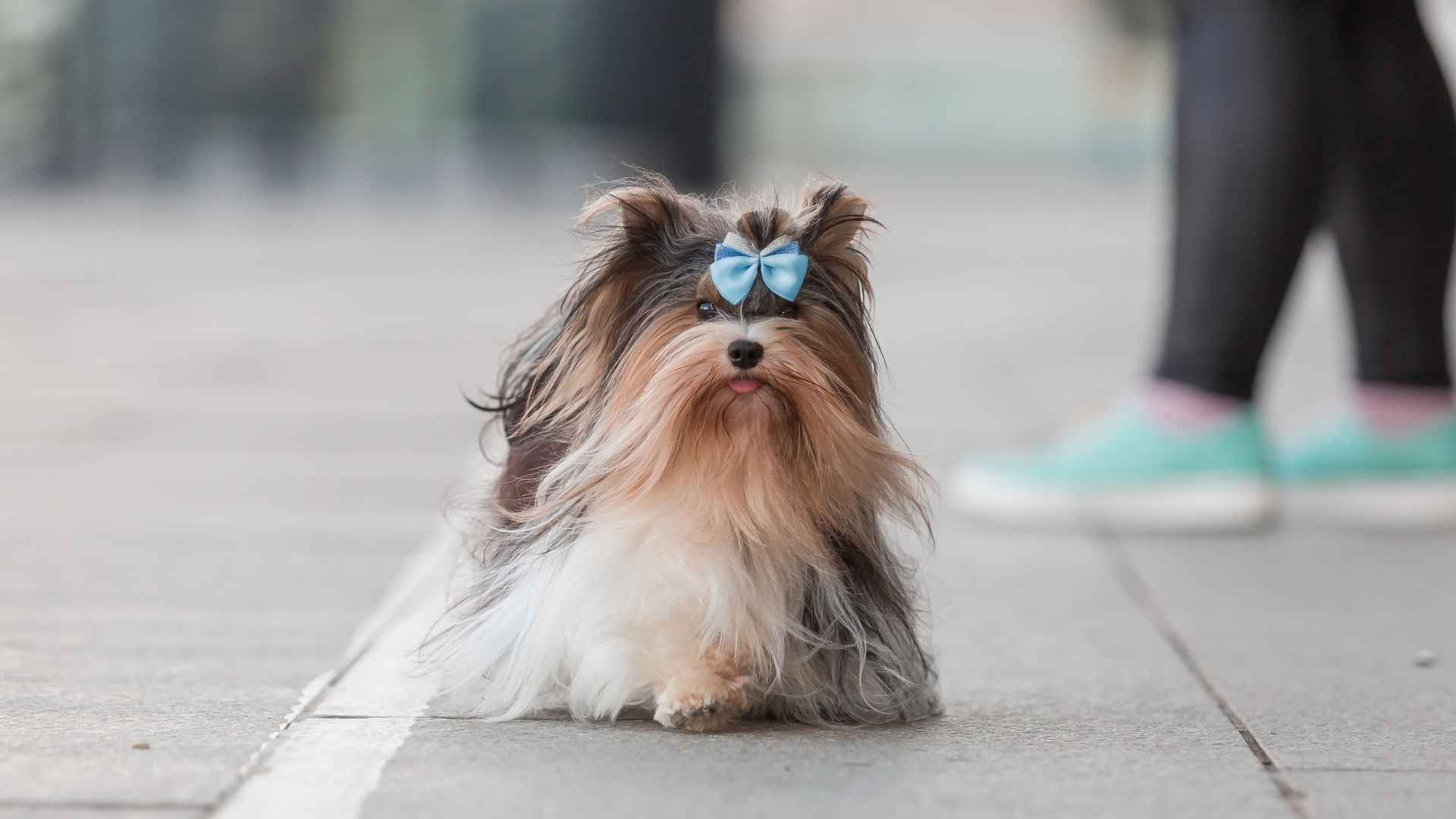There’s something truly special about having a dog that sticks by your side through thick and thin! Imagine having that loyal companion not just for a few years, but for decades. The bearded dog breeds are not only adorable but also incredibly long-lived.
With lifespans that can stretch well beyond 15 years, these dogs are the perfect choice for anyone looking for a companion that will grow old with them.
Whether you’re looking for a playful pup or a calm, affectionate friend, these seven breeds are sure to steal your heart and be by your side for a lifetime.
Bearded Companion Dog Breeds with a Long Lifespan
1. Bearded Collie

The Bearded Collie, originally bred in Scotland for herding sheep in rugged weather, is instantly recognizable by its flowing coat and signature facial hair. Its playful charm and windswept “beard” have made it a favorite among shaggy-coated breeds. This dog looks like it stepped straight out of a storybook. Its lively expression and trademark beard are impossible to miss.
This breed has a cheerful, energetic spirit that lights up any room it walks into. These Collies are known for their friendly nature and boundless enthusiasm, as the Show Sight Magazine claims. They get along well with other dogs and thrive in social settings where they can interact and play. Despite their working roots, they’re total charmers at heart.
For pet parents seeking a fun, affectionate companion, this breed checks all the boxes. They’re loyal, intelligent, and have a mischievous streak that keeps life interesting. These dogs adore being involved in daily activities and form deep bonds with their humans. Whether it’s cuddling or outdoor adventures, they’re all in.
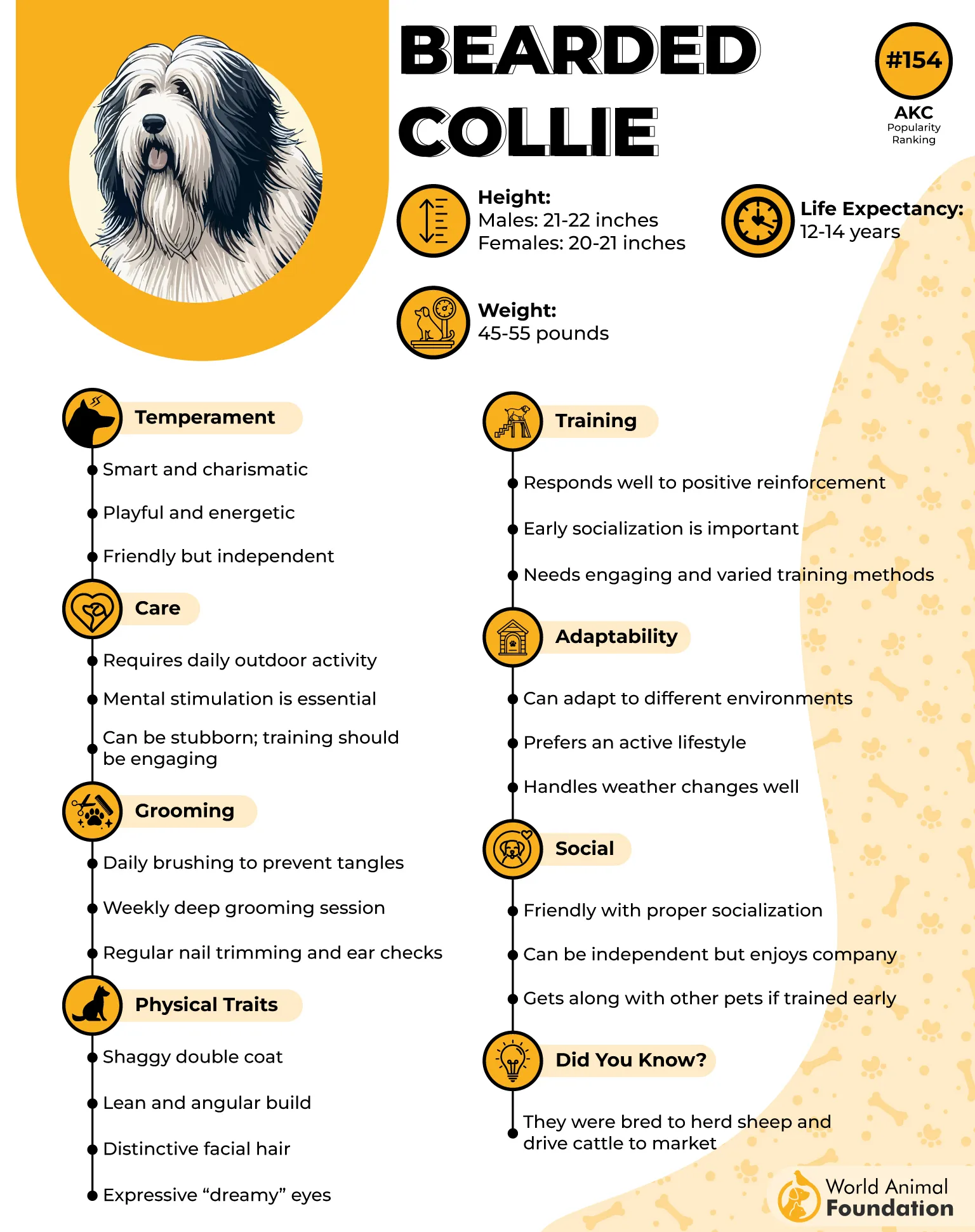
With proper care, they often enjoy a lifespan of 12 to 14 years. They’re generally healthy but can be prone to conditions like hip dysplasia and hypothyroidism. Regular vet visits and a good diet go a long way in keeping them happy and active. Their long lives make the companionship even more rewarding.
Keeping that glorious coat in check is a full-time job, especially the beard! Weekly brushing is essential to prevent mats, and many owners opt for daily touch-ups. Food and water love to hide in their facial hair, so a quick clean-up is part of the routine. It’s a bit of effort, but their stylish look is totally worth it.
2. Brussels Griffon
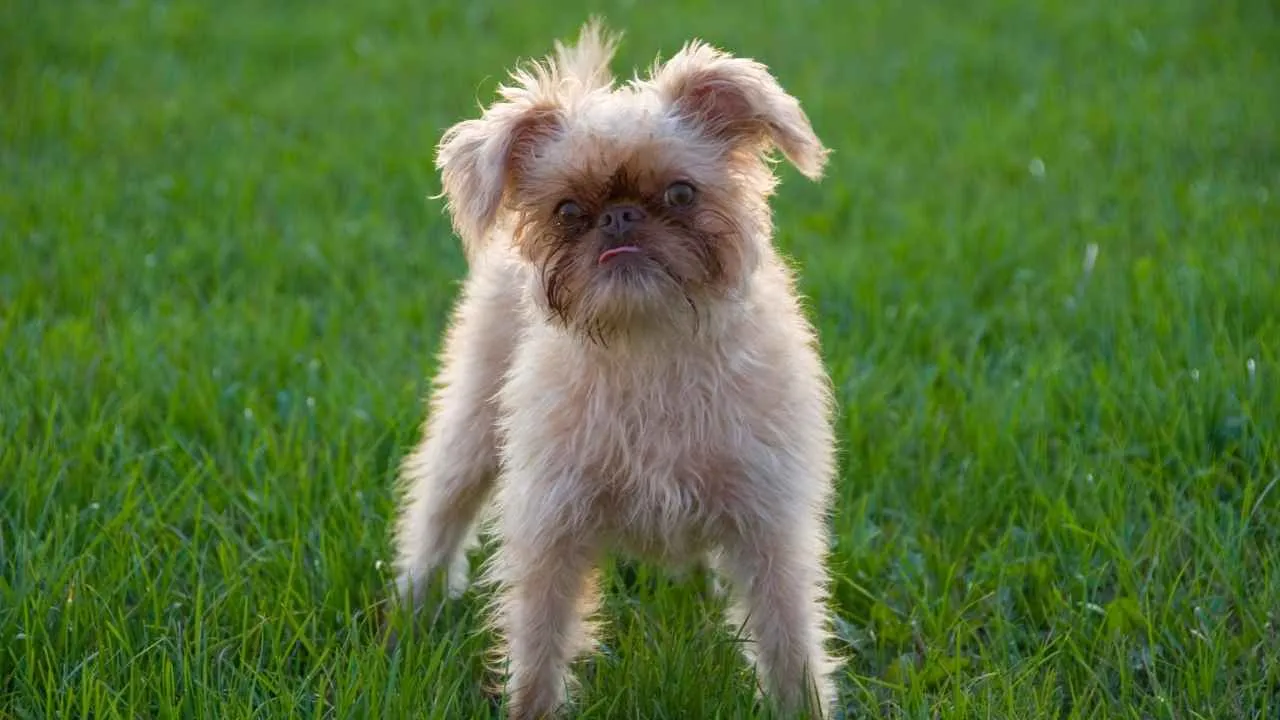
It’s hard to ignore the Brussels Griffon’s expressive little face—like a grumpy old man in a tiny dog body, and we mean that as the highest compliment. This specific breed was a favorite in 19th-century Europe, charming its way into royal laps and artists’ portraits alike. Whether strutting with a smooth or wiry coat, they’ve got an irresistible flair.
These pups don’t just like being around you—they demand a front-row seat to your entire life. What makes them so deeply affectionate is how intently they observe their humans, reacting to moods with impressive emotional awareness. From dramatic sighs to joyful zoomies, they’re little empaths in dog form.
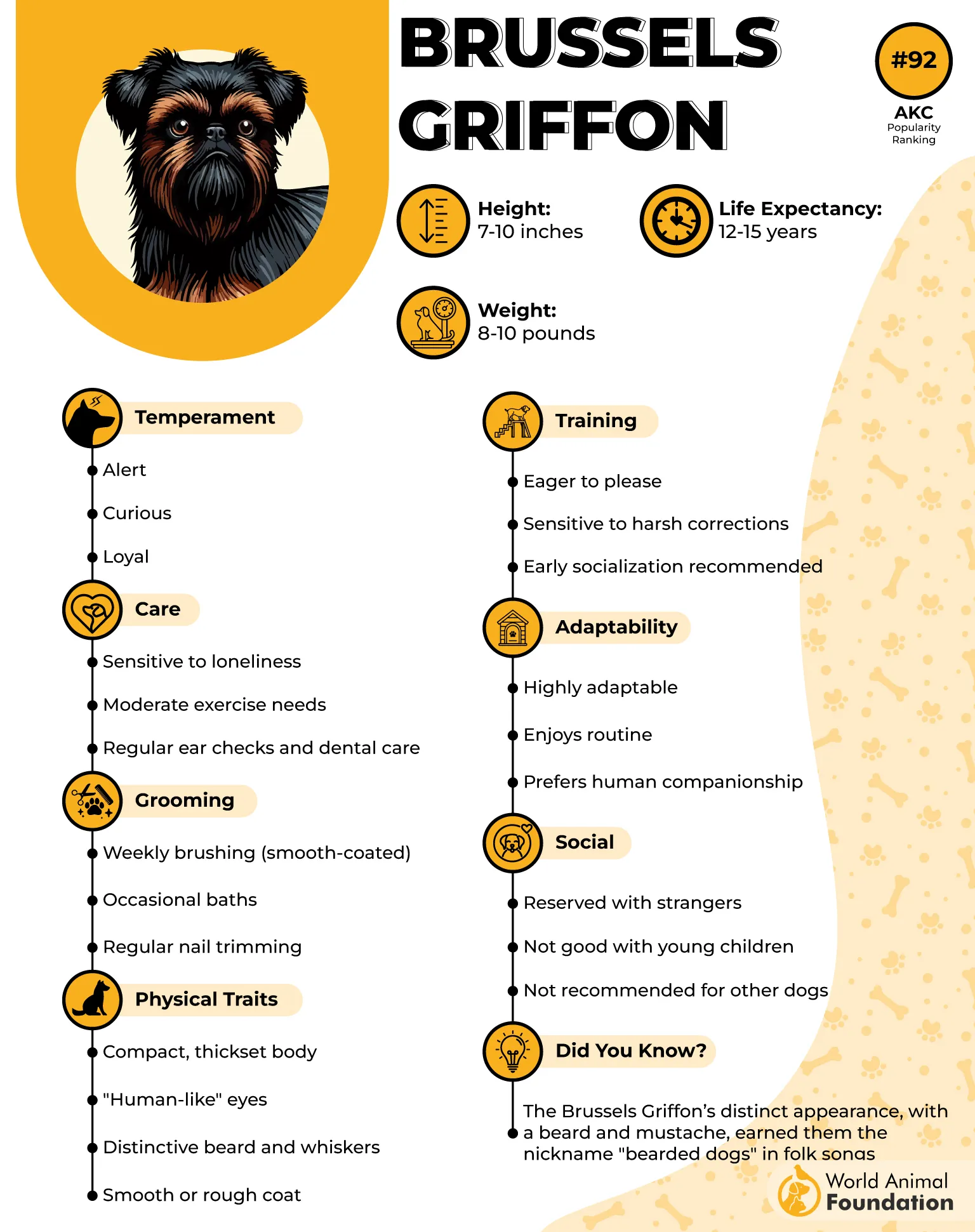
Even in their young age, Brussels Griffons act like wise, bearded philosophers trapped in toy-sized bodies. Their curiosity leads them to sniff out every sock, creaky floorboard, and crumb like it holds ancient secrets. They’re alert, thoughtful, and have a playful stubbornness that somehow feels charming instead of frustrating. They’re tiny thinkers with big opinions.
They typically live a long, healthy life (12-15 years), especially when their coat stays healthy and they’re on a well-balanced diet. Still, some health concerns may include issues like respiratory sensitivity and eye conditions due to their short snout and prominent features. Regular vet checkups help keep them in tip-top shape. Prevention is key with these sensitive souls.
Grooming their wiry coat is less about vanity and more about helping them feel their best, especially since mats can make them grumpy. A slicker brush and the occasional hand-stripping go a long way. Bath time is a drama performance, but post-bath zoomies are worth it. Good hair days are practically part of their personality.
3. Miniature Schnauzer
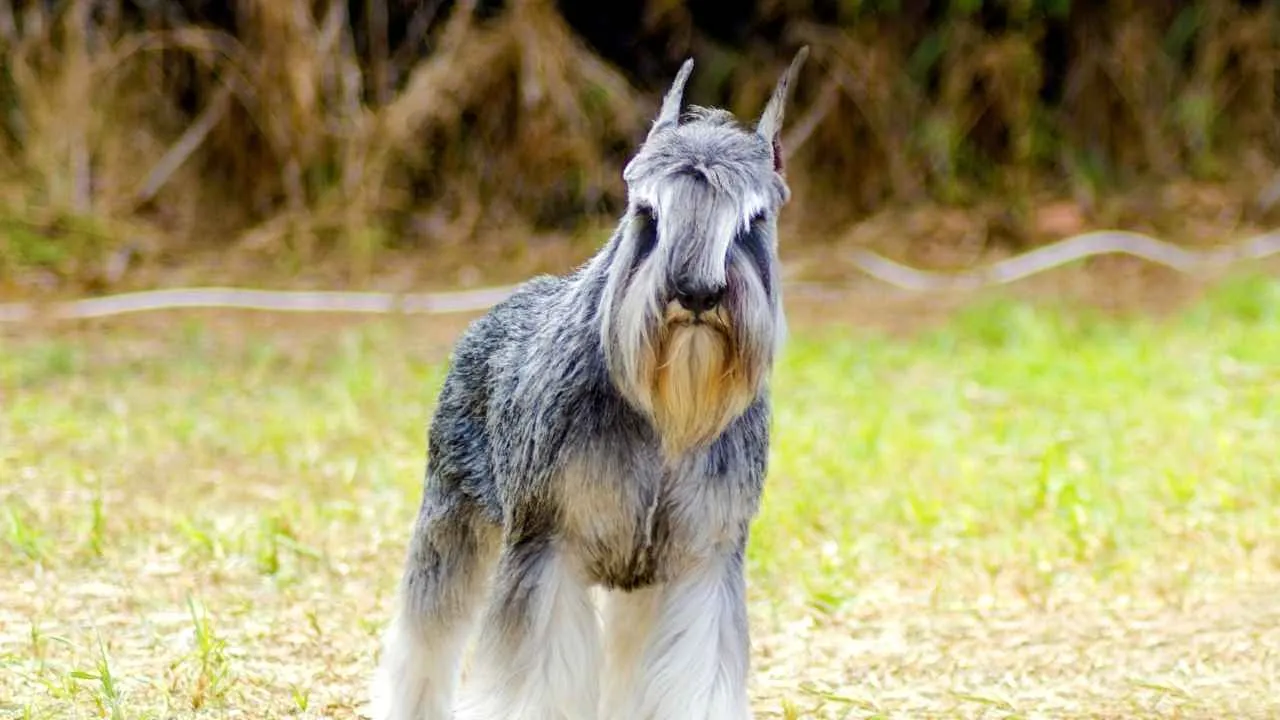
That expressive face, complete with a distinctive beard, gives the Miniature Schnauzer a look of serious business, even when they’re chasing a leaf. Their sharp appearance mirrors their alert, on-the-job energy. These dogs were originally developed to catch rats on farms, and that work ethic still lives on.
Despite their go-go-go attitude, they melt into calmness when lounging with their favorite humans and other pets. You’ll often find them nose-to-nose with the cat or curled beside the family rabbit like they’ve got a peace treaty to uphold. Their adaptability comes from a need to belong rather than dominate. It’s less about hierarchy and more about heart.

One thing Miniature Schnauzers never skip out on? A good conversation, usually in the form of expressive barks, chirps, or what sounds like tiny speeches. These little talkers are intuitive and quick to learn routines, thriving on being part of the action.
Mini Schnauzers are known for thriving well into their teens, as small breeds often do, especially with regular care. Keeping their coat healthy, teeth clean, and meals portioned helps extend those zoomie-filled years. Vets love them for their resilience, but they do appreciate a solid nap after each check-up.
That distinctive beard traps crumbs, collects morning dew, and somehow adds extra sass to their expressions. Grooming time involves thorough brushing and trimming, especially around the face and legs. They’re low-shedding but high-maintenance—basically the canine version of “effortlessly styled.”
4. Lhasa Apso
There’s a royal kind of drama that comes with a Lhasa Apso’s entrance, mostly due to that lavish facial hair flowing like a curtain around their face. Originally bred to guard Tibetan palaces, they still walk like they own the hallway. Their small size doesn’t stop them from taking center stage. It’s not arrogance, it’s historical confidence.
You don’t live with a Lhasa Apso, you earn the privilege of being their family member. They’ll follow you from room to room, not for attention, but for silent supervision. The way they rest their head on your foot after a long day? That’s loyalty with a side of fluffy wisdom. They may be small, but their bond is big.
These little charmers are known to live up to 20 years (12-15 years on average), often surprising folks with their longevity. However, they can be prone to certain health conditions, like kidney issues and progressive retinal atrophy. Regular checkups help spot concerns before they grow legs. Think of them as sprightly seniors with good retirement plans.
Their coat doesn’t just grow, it flows, and it’s high-maintenance in the most fabulous way. Regular grooming is a must if you want to see their eyes and keep those long locks untangled, as mentioned in Britannica. Some owners trim it short, others commit to the show-dog look. Either way, brushing is basically a love language here.
Lhasas are generally sturdy, but it’s smart to watch for early signs of health problems, especially related to their eyes and breathing. A good diet, daily strolls, and a stress-free routine can add years to their already impressive lifespan. They age like vintage wine—low-key, wise, and full of stories.
5. Scottish Terrier
The Scottish Terrier might be small in size, but this breed struts with a big personality that takes over the room without even trying. That proud walk, confident posture, and signature beard scream “VIP entrance only.” They’re classy, bold, and unapologetically themselves, 24/7.
Their unique appearance turns heads on the street. Their short legs, long body, and that iconic silhouette look like they stepped out of a vintage painting. With a coat that’s more tailored than most people’s wardrobes, Scotties don’t do “messy chic”; they do stylish and serious, minus the serious part.
They’re not pushovers, that’s for sure. A stubborn streak runs strong in this breed, especially when they’ve already decided the game plan for the day. But behind that sass is a heart of loyalty, just don’t expect them to change their mind once it’s made up. They do things the Scottie way.
What keeps this breed happy? Brain games, puzzles, and switching things up now and then. They’re highly intelligent and thrive when they’re given the right mental stimulation, otherwise they’ll find their own fun—and that can include digging or ignoring your commands with flair.
Scotties live long and proud lives, often reaching 12 to 15 years, and their strong personality never dims with age. They’re the kind of companion that matures with elegance but never really “settles down.” As long as they’re part of the action, they’re thriving.
6. Yorkshire Terrier
Yorkshire Terriers may be small, but they come from bold, spirited terrier breeds that were never meant to blend into the background. They’ve got attitude in spades, along with a sense of determination that makes them impossible to ignore.
What makes them especially eye-catching is that sleek coat and distinct beard that gives them a “tiny old soul” vibe. It’s like they’ve seen things—maybe your lunch from the countertop—and they’re silently judging. Add a bow or let it flow, their look always turns heads on a walk.
These pups are a great match for active households, especially the ones that don’t mind a little sass served daily. They love playtime, zoomies, and even short training sessions—as long as they get to show off in the end. Keep them busy and they’ll reward you with endless enthusiasm.
Even with their charming personalities, Yorkies don’t hold back when it comes to loyalty. Once they choose you, it’s unconditional love all the way—lap naps, hallway follows, and protective instincts all included. You’ll never go to the bathroom alone again, and honestly, that’s kind of sweet.
With proper care, these feisty charmers can live anywhere from 11 to 15 years, often outlasting much larger breeds. Their small frame might age, but the spark doesn’t fade. They’re like tiny batteries powered by stubbornness and affection, with a long-lasting charge.
7. West Highland Terrier
There’s something forever cheerful about a West Highland Terrier. Their sturdy little body moves with a bounce like they’ve always got a plan (and it usually involves treats). Among many purebreds, few carry such a mix of charm and confidence in such a compact form.
Westies are surprisingly tolerant around kids, especially those who respect personal space (and don’t yank tails). They won’t hesitate to join in on backyard games or just sit quietly during cartoon marathons. Playful, yes—but with a dash of independence that keeps things balanced.
They may look like lap dogs, but Westies thrive on the go. Whether it’s chasing squirrels or inspecting new trails, they’ve got that classic terrier energy that needs an outlet. Toss in a toy or two, and they’ll be busy running laps while the rest of the world takes a break.
You’ll find that Westies usually get along well with other animals, provided introductions are done properly. They’ve got a big-dog mindset in a little package and a healthy curiosity about their surroundings. Sniffing out adventure is basically their part-time job.
This energetic fluffball can stay by your side for 13 to 15 years if cared for right, making them a pretty solid long-term roommate. Their health tends to be stable, and they age gracefully, like the kind of dog that still wants to hike at 12 but insists on doing it in style.
Conclusion
Long-living dogs don’t just happen—they need the right mix of love, care, and just the right space. A fenced-in yard lets them stretch their legs without a worry. And trust us, freedom to roam makes a big difference.
Many breeds on our list benefit from daily exercise, not just for their bodies, but their moods. A happy walk, a gentle run keeps those tails wagging. And honestly, it keeps us active too.
Some small breeds are prone to heart disease, especially in older age. But regular vet visits and a healthy diet can do wonders. Think of it as preventative love.
Don’t underestimate grooming, especially for the fluffier pals. A coat that’s brushed weekly stays tangle-free and comfortable. Plus, it’s a great bonding ritual.
Dogs with longer hair often need daily brushing to avoid mats and itchiness. It also helps you spot early signs of eye problems before they become serious. Care today means cuddles tomorrow.


